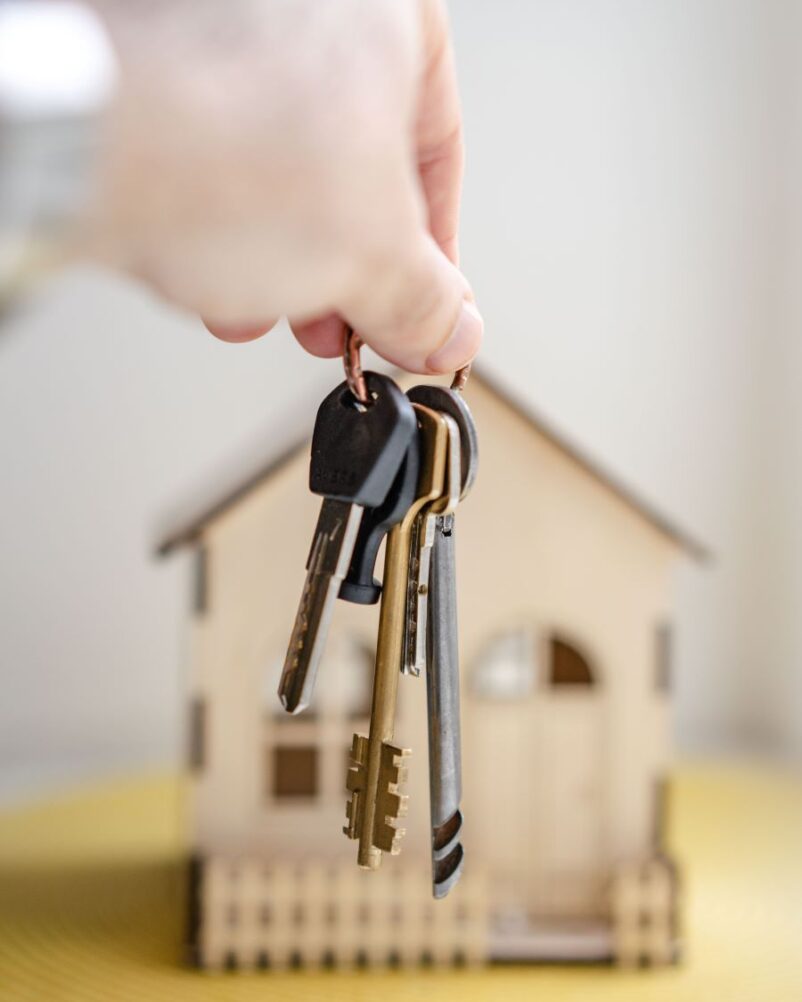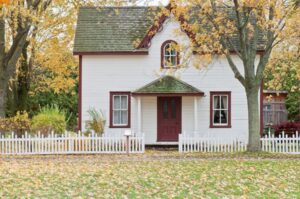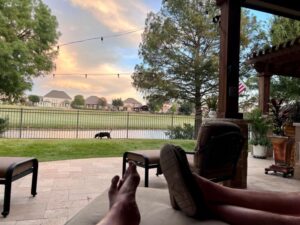
As retirement approaches, many individuals find themselves at a crossroads, faced with a difficult downsizing home decision. It’s a choice that carries significant financial and lifestyle implications, but one that is increasingly popular among retirees.
The appeal of a small house layout can be irresistible for those looking to simplify their lives and reduce expenses.
Yet, going with a small house layout also raises questions about sentimental attachments and the fear of letting go, especially of cherished memories. There are advantages and challenges of downsizing home for retirement. Here are helpful tips and insights to guide you through this transformative process.
The Benefits of Downsizing Home for Retirement
The decision for downsizing home for retirement can bring numerous benefits that extend beyond just financial savings.
 First, choosing a small house layout allows you to simplify your life and reduce the amount of physical and emotional clutter weighing you down.
First, choosing a small house layout allows you to simplify your life and reduce the amount of physical and emotional clutter weighing you down.
By letting go of unused or unnecessary belongings, you not only create a more streamlined living space but also experience a sense of liberation and freedom from material possessions.
Additionally, the merits for downsizing home results in lower maintenance responsibilities and costs, giving you more time and resources to focus on enjoying your retirement years. With a small home layout, there’s less yard work, fewer repairs, and reduced cleaning tasks on your plate.
This means more opportunities for leisure activities, relaxation, travel adventures or pursuing hobbies that may have been neglected while managing a larger property.
Furthermore, paring down can promote social connections in retirement. Moving into a small home layout or even a retirement community offers the chance to meet new people who are going through similar life transitions.
Engaging with like-minded individuals can foster relationships and create a supportive social network that enhances your overall quality of life during this stage of downsizing home.
Evaluate Your Current Living Situation Before Downsizing Home
As retirement approaches, evaluating your current living situation becomes essential. This is the time to reflect on whether your current home still suits your needs and goals for the future. Downsizing can offer numerous benefits, such as financial savings, reduced maintenance, and a simpler lifestyle.
However, before making any decisions, it’s crucial to assess various aspects of your current living situation objectively.
One key consideration is the size of your current home. Are there rooms that rarely get used? Do you find yourself constantly cleaning and maintaining an unnecessarily large space?
Making the decision for downsizing home to a small house layout can not only save you money on utility bills but also free up time for activities that you enjoy in retirement. Additionally, downsizing allows you to declutter and get rid of possessions that no longer serve a purpose or bring you joy.
Another aspect to evaluate is location. Is your current home situated close to amenities such as grocery stores, medical facilities, and recreational activities? If not, moving to a more convenient location can greatly improve your daily life during retirement. Consider proximity to family and friends as well – being closer to loved ones can provide emotional support and opportunities for socialization.
When evaluating your living situation for retirement downsizing, it’s essential to consider factors beyond financials alone. Reflecting on the practicality of your space in terms of size and location will help ensure that the choice you make aligns with both your present needs and future aspirations.
Determining Your Ideal Retirement Home Size
When it comes to determining your ideal retirement home size, there are several factors to consider. First and foremost, think about your current lifestyle and what you envision for your future. Are you someone who enjoys hosting family gatherings and having ample space for guests? Or do you prefer a simpler, more low-maintenance lifestyle?
Understanding how you want to spend your retirement years will help guide your decision on the appropriate size of your new home.
Another important consideration is financial stability. Downsizing to a small home layout can often lead to significant cost savings, both in terms of mortgage payments and monthly expenses.
By reducing the square footage of your living space, you can potentially free up more funds for travel, hobbies, or supporting charitable causes that are meaningful to you.
Furthermore, it’s essential to plan ahead for any potential health issues or mobility challenges that may arise as you age. A small home layout with fewer stairs and less maintenance can provide greater convenience and accessibility in the long run.
Additionally, opting for a single-level floor plan or a community that offers comprehensive medical care services could make aging in place easier and more comfortable.
Downsizing home size can involve considering various factors such as lifestyle preferences, financial stability, and future needs. By carefully assessing these aspects and making an informed decision based on personal goals and circumstances, individuals can find a retirement home that perfectly suits their needs while also providing the opportunity for a fulfilling post-retirement life.
Tips for Decluttering and Organizing Before Moving to Small Home Layout
When it comes to downsizing home for retirement, decluttering and organizing before the move is crucial. Moving is already a stressful process, and having excess belongings can make it even more overwhelming.
To make the transition smoother, consider decluttering and organizing beforehand.
3 Tips for Consolidating When Downsizing Home
It’s important to start early.
Give yourself plenty of time to go through your belongings and decide what to keep, donate, or discard. Begin with one room at a time and tackle smaller spaces first.This will give you a sense of accomplishment and motivation to continue throughout the rest of the house.
Categorize your items into different groups.
Sorting your items into groups such as keep, sell/donate, or toss/recycle will help you prioritize what is essential and what can be let go of.Be ruthless when deciding what to keep; only hold on to items that have practical use or sentimental value.
Utilize storage solutions that maximize space efficiency.
Invest in furniture with built-in storage compartments or opt for stackable boxes that can fit neatly in closets or under beds. This way, you’ll not only have an organized living space but also prevent clutter from building up again.
By following these decluttering and organizing tips before your downsizing home move, you’ll reduce stress during the transition period and start your retirement with a clean slate – both physically and mentally.
Downsizing Home and Finding a Small House Layout
 Selling your current home and finding a new one can be an overwhelming process, especially when downsizing home for retirement. It’s a unique journey that requires careful planning and strategic decision-making.
Selling your current home and finding a new one can be an overwhelming process, especially when downsizing home for retirement. It’s a unique journey that requires careful planning and strategic decision-making.
One key aspect to consider is the timing of selling your current home. While it may seem logical to sell first before looking for a new house, this approach could potentially leave you without a place to live if you don’t find the right home quickly enough.
Consider exploring options such as short-term rentals or staying with family or friends until you find your dream retirement small house layout.
When searching for a new home, think beyond just the physical features and location. Retirement is an opportunity to redefine your lifestyle and prioritize what truly matters to you. Take into consideration factors such as community amenities, access to healthcare facilities, recreational opportunities, and proximity to essential services like grocery stores and restaurants.
Look for neighborhoods that offer social activities catered towards retirees, such as book clubs or yoga classes specifically designed for seniors. Remember that downsizing home doesn’t mean compromising on quality of life; in fact, it’s an opportunity to enhance it.
Navigating the process of selling your current home and finding a small house layout can be stressful but remember why you are doing this in the first place: to create a comfortable and fulfilling retirement experience.
It may feel emotionally daunting to let go of memories associated with your old house, but also keep in mind that downsizing home will reduce maintenance efforts and expenses while freeing up resources for other important aspects of retirement living.
Adjusting to a Small House Layout in Retirement
When it comes to retiring, downsizing home to a smaller space can feel like a big adjustment. After years spent in a larger home, it’s only natural to have reservations about moving into a more compact living environment.
 However, with the right mindset and approach, adjusting to a small house layout in retirement can actually be quite liberating.
However, with the right mindset and approach, adjusting to a small house layout in retirement can actually be quite liberating.
One advantage of downsizing home is the opportunity to simplify your life. With less square footage to maintain, you’ll find that you have more time and energy for the things that truly matter.
Plus, having fewer possessions means there’s less clutter and more freedom to focus on experiences rather than material belongings.
Another aspect of adjusting to a smaller space is redefining what home means to you. In retirement, your priorities may shift from owning an expansive property to enjoying greater flexibility and financial freedom.
Embrace this new chapter as an opportunity for personal growth and exploration. Look for ways to make your small space feel cozy and personalized by utilizing clever storage solutions and showcasing meaningful mementos or artwork.
By embracing the benefits of downsizing – simplicity, freedom, and flexibility – adjusting to a smaller space in retirement becomes an exciting adventure rather than a daunting task. With an open mind and willingness to let go of unnecessary belongings, you’ll discover that your new abode has all the charm necessary for creating delightful memories in this next stage of life.
Small House Layout: What You will Be giving up
When considering downsizing to a small house layout, it is crucial to acknowledge the things you may be giving up in terms of space. A smaller house layout means limited room for storage and fewer areas to entertain guests comfortably.
You might have to say goodbye to that spacious living room or separate dining area with full table and china cabinet, making it challenging to accommodate large gatherings or host parties.
Additionally, downsizing may require you to part with some beloved possessions due to lack of storage space, forcing you to prioritize and declutter.
Another area you may have to forgo is the large, soaking or jacuzzi-style bathtubs. The tubs are a huge footprint in a home, and if you downsize home to a small house layout, a larger and perhaps safer shower style will be a better option instead.
Builders say that people don’t use their tubs like they used to, and the new rule seems to be that if there is one bathtub or bath/shower style in a home (doesn’t need to be in master), then resale will be unaffected with the absence of a large tub.
 Furniture may need to be downsized in a smaller home as well. Large furniture pieces, especially the more mammoth styles of solid oak and mahogany favored by generations until current trends, may not work in a small home layout.
Furniture may need to be downsized in a smaller home as well. Large furniture pieces, especially the more mammoth styles of solid oak and mahogany favored by generations until current trends, may not work in a small home layout.
Keep in mind that if you had planned on giving away all your treasured family heirlooms, including furniture, knick-knacks, china, and crystal, you might be surprised to find your children and/or grandchildren don’t want them.
Times and tastes have changed, and higher home prices and inflation have meant smaller homes in many cases for the younger generation.
Read more about family not wanting your heirlooms here.
Another aspect worth considering in regard to downsizing home is the potential impact on your lifestyle. A smaller house layout can restrict your ability to indulge in hobbies that require ample area such as arts and crafts, workout equipment setup, or a dedicated home office.
In addition, if family visits are a regular occurrence for you, downsizing could limit their comfort and create additional challenges in hosting them overnight or providing adequate privacy for all family members staying under one roof.
While small house layouts have their limitations and necessitate certain sacrifices, they also offer unique advantages that cannot be overlooked.
By embracing a compact living arrangement, you inevitably reduce maintenance tasks associated with larger homes like having to clean big spaces or maintaining vast gardens. Moreover, opting for a smaller house layout often translates into lower utility bills due to reduced energy consumption requirements.
Additionally, downsizing enables simpler living where less emphasis is placed on accumulating material possessions and more on creating experiences and cherishing meaningful connections with loved ones.
Enjoying the Freedom of Downsizing Home
Downsizing for retirement offers numerous benefits that can greatly enhance your overall quality of life. One of the first steps in this process is evaluating your current living situation.
Take a moment to consider whether your current home meets your needs and if it will be sustainable for you as you enter retirement.
Our Personal Journey on Changing Homes After Almost 20 Years
Rick and I moved in 2019 from a city we had called home since 1994. We had actually built the home of our dreams there in 2001 due to a growing family and were very happy. But once kids moved on and out, the home seemed impractical, especially with three bedrooms upstairs.
We moved to a configuration where all bedrooms are downstairs and the layout if open and easy to move around in, especially as we age. We didn’t downsize our square footage, but instead opted for a home with more lifestyle choices.
 The yard is smaller, and the front yard is maintained by the HOA. Our small backyard backs up to a pond, and makes the perfect spot for enjoying morning coffee while watching geese and ducks swim.
The yard is smaller, and the front yard is maintained by the HOA. Our small backyard backs up to a pond, and makes the perfect spot for enjoying morning coffee while watching geese and ducks swim.
It’s also on a golf course, a hobby my husband hopes to spend more time with once he retires.
Because the home was newer, we have better insulation, tankless hot water heaters, and more energy-efficient windows, things that have made a definite difference in our utility bills. Once we fully retire, it will be especially nice to see those cost savings every month.
Our children didn’t really want us to move, of course. They talked about how they miss their childhood home and thought we would live there forever. I’m glad they miss it, because that means a foundation of good times and great memories were created there. I miss it too.
But this home just feels right for where we are in life now and it was our choice to make. And I love it as well, so no regrets.
Now, if I can just being the process of going through boxes of treasures and downsizing all the things that are no longer the right fit today.
More stories about retirement and whether it’s the right time for you can be found below:
- Unlock Hidden Opportunities: Discover the Best Part-Time Jobs for Retirement
- The Rise of Unretiring: Why Are People Coming Out of Retirement?
- 8 Critical Questions to Ask Before Collecting Social Security
- Maximizing Income and Security: 9 Reasons to Delay Retirement
- 9 Powerful Reasons Why You Can and Should Retire Today
Written by
Robin McClure
Robin is the author of 7 parenting books and has 3 grown children, 3 spoiled rescue dogs, and a very understanding husband. She holds a bachelor's degree in journalism and a master's degree in communications, and spends her time writing, drinking coffee, and planning the next grand adventure.



